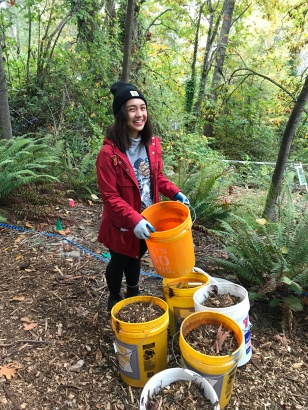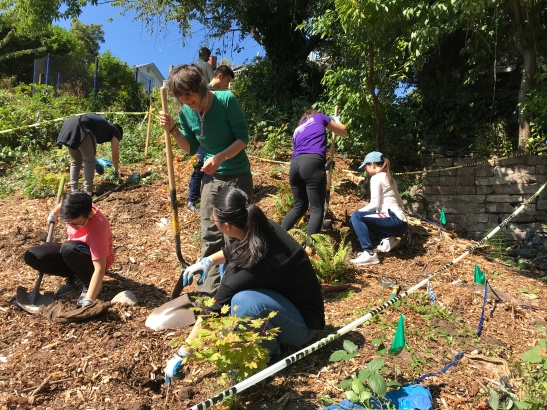
The August 4th work party went faster than any work party I can remember. I was so surprised when I looked at my watch and saw how much time had passed. I suspect that time warp happened in part because the temperature that day was in the high 60’s. The previous three work parties had been in mid to high 80’s weather. It had felt oppressive to work in those conditions and we had moved from place to place to avoid the hot sun. We were relieved to be working when the temperature was in the 60’s once again.
Fifteen volunteers participated in the event. Five were GreenFriends members, seven were UW Environmental science students and three were neighbors.
Our primary goal for this event was to work in areas we had avoided when the sun was so hot. We would do that work until break time and then, after the break, we would move to the Greenbelt site that is just north of ours.
Over the three-hour period, we worked in five different areas. This report is going to be pictorial, with photos showing what each area looked like before, during and after the work.
Area 1
After the initial orientation, all of the participants worked in the planting area that is in the southwestern part of the site. There, many blackberry sprouts had been growing among the native plants. Not only did the volunteers remove most of those blackberry plants, but they also partially or completely cleared blackberry vines and root balls from the area outside the southern and western borders of that space.
(Click on any of the photo galleries to enlarge the pictures.)
Before
During
After

Part of the planting area

Southern border

Western border
Area 2
An hour into the work party, a few of the volunteers moved to the second area. They spent a half-hour removing blackberry vines that were growing around and through piles of debris as well as bindweed that had invaded a nearby planting area. There is more to be done in this area in the future, but this group made a lot of headway.
Before
During
After
Break Time
An hour-and-a-half into the work party, we took a short break. Among the snacks we offered were ice cream and watermelon. The students decided to include the ice cream in the group photo!

After the break, we moved to the site that is north of the Hanford Stairs. Once there, we divided into three groups. During the next 45 minutes we worked in areas three, four and five.
Area 3
The third area had a big leaf maple tree with lots of suckers growing from it. Blackberry plants and invasive ground covers grew around it. The students removed the suckers and some of the invasive plants. It will be interesting to see how the tree changes now that the suckers have been removed.
Before
During
After
Area 4
The fourth area was 20-30 feet into the Greenbelt. It was not visible from the road that borders the area. This group removed ivy and other weeds from under several 10-15 year-old evergreen trees; and cut down any blackberry vines that were growing through them. They also cut ivy from an old evergreen tree and removed a number of blackberry plants from the area
Before
During

After
Area 5
My neighbor John and I started working in an area that runs parallel to 25th Avenue South several months ago. Volunteers also worked on it during some of the July work parties. During one of those work parties, John removed enough blackberry vines that he broke into a space that he and I had cleared last Spring. I was so excited to see the two spaces connected.
On August 1 and 2, another volunteer worked seven hours in the same area. Once he cleared some of the ground, he and I built two drying racks to use at future work parties. (When we cut down blackberries, ivy and bindweed we put them on drying racks so they can’t reach the ground and re-root.)
The photo below shows what this area looked like at the beginning of the August 4th work party. During the work party, volunteers focused on cutting sections out of fallen trees that crossed the area we were clearing. Walking over them could be hazardous and we wanted to prevent accidents by creating a clear path. They also dug out blackberry root balls and raked up dried leaves and other debris. The last photo shows the transformation that occurred during the last forty-five minutes of the work party.
Before
During
After

Another work party was complete, and once again the changes in the land that occurred during the three hours of working together was remarkable. I love how every person that helps with this project makes a difference. That proverb, “many hands make light work,” is so true.














































































































































